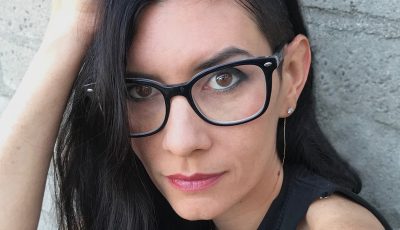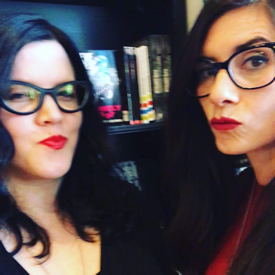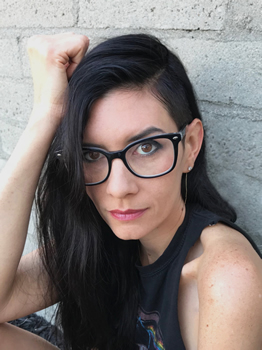

Up Close: Wendy Heard
Girls on the Edge
In Wendy Heard’s stellar young adult debut SHE’S TOO PRETTY TO BURN, an ambitious, charismatic young photographer named Veronica wastes no time falling head over heels for Micaela (“Mick”), a shy, alluring girl she meets at a party and sweeps off for a night of adventure in their native San Diego. Veronica’s best friend, a charming guerilla artist named Nico, takes one look at Mick and pegs her as a “girl on the edge.” The question is who’ll give Mick the final shove, and how devastating the results will be for Mick and everyone in her orbit—including Veronica.
Propelled by a trio of compelling characters and wrapped in gorgeous, cinematic prose, SHE’S TOO PRETTY TO BURN is a master class in mood and pacing. The first half is a swoony romance with sinister undercurrents, while the second half is a twisty, fast-paced thriller that still gives its expertly drawn characters room to breathe. The result is an immersive read that’s just as recommended for adult suspense fans as teen readers.
The Big Thrill caught up with Heard a few days before the book’s release for a lively discussion about writing thrillers for young readers, the ruthless editing rule she applied to every scene in the book, and her next YA thriller about ambitious girls with dangerous plans.
This is your YA debut, but it’s not the first YA novel you’ve written. Can you elaborate?
I started out writing YA! The first book idea I had after taking a years-long break from writing was a YA mystery/thriller. After writing a few of those, I moved on to some adult books, and I ended up publishing my debut, Hunting Annabelle. That said, my adult books lean young for the genre.
In what ways do you find writing for the YA category different than writing an adult thriller?
I consider carefully what might be better explored from a teen perspective, and what to save for an adult book. It’s not about sheltering teens from dark content; in fact, SHE’S TOO PRETTY TO BURN has some extremely dark stuff in it. It’s more about choosing what kind of darkness. It’s certainly not an exact science!
This novel was inspired by The Picture of Dorian Gray. How did you get from Wilde’s story to a YA thriller set in the guerilla art scene?
Well, here’s a fun quote from Dorian Gray: “My dear boy, no woman is a genius. Women are a decorative sex. They never have anything to say, but they say it charmingly.” So if I’m being honest, I was pretty delighted to genderswap a reimagining of this story. I was also enamored with the idea of Sir Henry being an aspiring Banksy type, someone subversive asking the real questions. I also liked the idea of exploring the flip side of vanity: What does it mean to be the object of affection, the subject of a photograph? What does it mean to be the muse, and how does that lack of agency rub up against the power the artist holds in that relationship?
Wilde’s book is…not kind to women. How did it feel to write a feminist version of his story?
GREAT! Hahaha. It felt SO GREAT! I hope he’s rolling over in his grave.
I was struck by how fully realized the characters are; I felt genuine pain for them. How did Mick and Veronica take shape for you?
Veronica was easy. Her voice came to me first, and I loved the idea of a belligerently confident girl whose perspective is all ambition, all desire. Veronica knows what she wants, and she pursues it relentlessly, sometimes to the detriment of those around her. Nico was easy, too; I think I had his character first, actually. I just loved everything about Nico. He’s my truth-teller, the one who cuts to the bone. Mick was the hardest. She’s so raw, and she’s not totally aware of why she’s doing the things she’s doing. I was like that at her age: I’d do something self-destructive, but I’d have no idea why I was doing it. I wanted to write about the relationship she has with her mom and how that causes her to act out in all these ways she doesn’t yet understand. She’s a girl on the edge.
One thing I love about the SHE’S TOO PRETTY TO BURN is that, while Veronica and Mick have plenty of dangerous things to deal with, homophobia is never really one of them. Was that a conscious choice, or simply one that was dictated by the setting?
It was a conscious choice. My last thriller, The Kill Club, dealt with some homophobia, and perhaps I was a bit fatigued and couldn’t face writing any more for a while. Also, I wanted it to be clear that all the issues in this book have nothing to do with their sexual orientations. I wanted their queerness to be background noise, like the setting of the book rather than the plot.

Heard at the January 2020 book launch for her second adult thriller, The Kill Club, at Book Soup in West Hollywood.
You’re a master of pacing—your novels keep the twists coming hard and fast, but you still give your stories and characters time to breathe. Are there any tools or techniques that you find particularly helpful?
Thank you so much for saying that! I worked a lot on this book’s pacing because the first half is more romance and the second half is more thriller. Knowing that, I wanted to bring suspense into the first half via atmosphere and romance into the second half via conflict and stakes. Ultimately, this book was shorter than I’d originally written it, and I had to cut a lot of extra stuff in order to make that happen. It’s very bare bones now; every single scene contains a plot point. I use that as a rule of thumb when editing: every scene has to move the plot forward. If it doesn’t, it needs to go, and any character development has to get worked into a plot point scene.
Along with Kristen Lepionka and Layne Fargo, you co-host a truly wonderful podcast called Unlikeable Female Characters. How did your work on the show influence the writing of SHE’S TOO PRETTY TO BURN?
I’m glad you like the podcast! I’ve been asked so much about the unlikeability of the girls in PRETTY TO BURN, which is funny. I didn’t mean to write unlikeable characters. In fact, I find it quite interesting that people find them unlikeable, because I think they’re really sympathetic. How can you be mad at Mick for falling apart when she’s dealing with so much? And how can you be mad at Veronica for being (gestures at Veronica) because she’s so much fun to be around? I think I just have a high tolerance for flaws in female characters. I find imperfections extremely likeable.

Heard with author and Unlikeable Female Characters co-host Layne Fargo (They Never Learn) at the Kill Club book launch.
If you could change one thing about publishing, what would it be?
Let me get out my banjo and sing you a country song called “Publishing”… I guess if I could only change one thing, I’d set it up so there’s an agreed-upon advance range from $50K-100K, and the negotiation point is around royalties and bonuses for sales goals. That way, you don’t have publishers pouring seven figures up front into an untested project, and you could still make the big bucks if your book sold a lot.
Can you tell us anything about Dead End Girls?
Finally, yes! This is a super fun project. It’s about Maude, an angry girl with a plan to get revenge on her terrible family: She’s going to fake her own death. She’s been planning it for two years and can’t wait to start a whole new life under a new identity. But on the eve of her escape, she gets caught by Frankie, a girl her age she knows through her stepfather’s family. She thinks her plan is ruined, which is devastating, but Frankie doesn’t want to rat her out. Frankie wants in; she has her own reasons for wanting to disappear forever. The two set out on an adventure that takes them from Hawaii to LA to Vegas, but each turn brings new dangers, and they’re forced to confront their own demons as they pursue their dream of starting a new life. But you can’t run away from yourself, and Frankie hasn’t been completely honest about what she’s running from…
- Between the Lines: Rita Mae Brown - March 31, 2023
- Between the Lines: Stephen Graham Jones - January 31, 2023
- Between the Lines: Grady Hendrix - December 30, 2022



